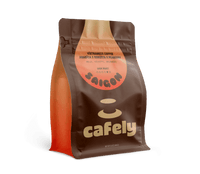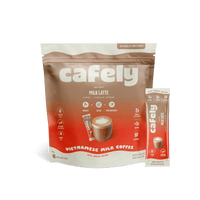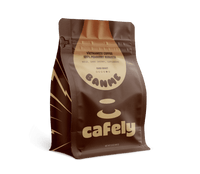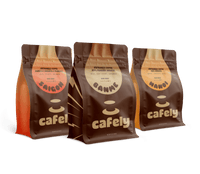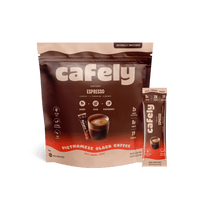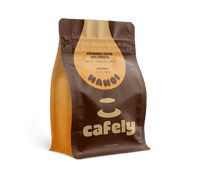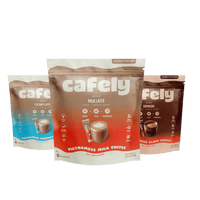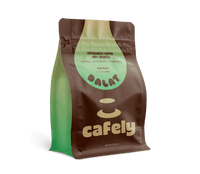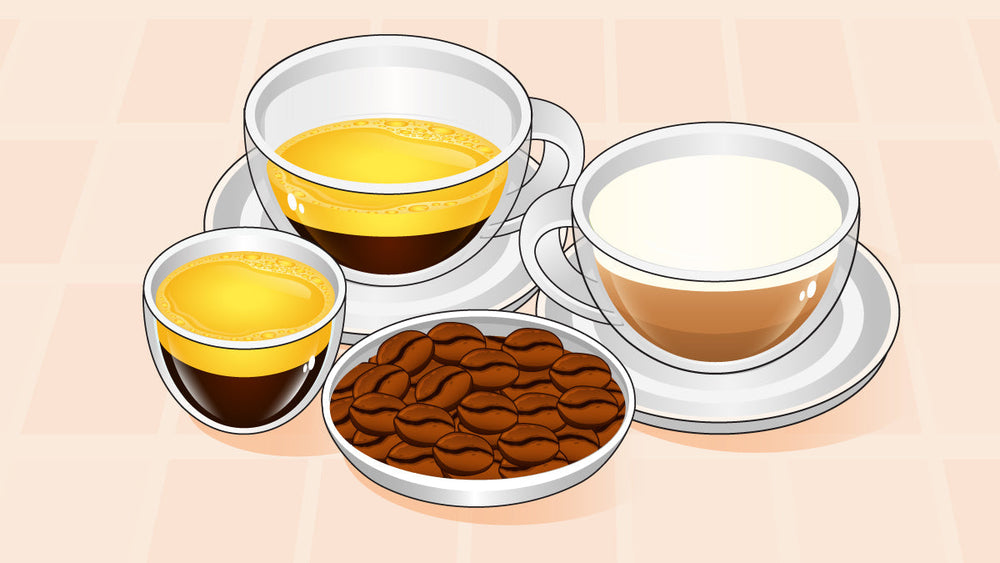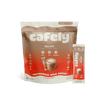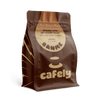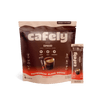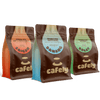Many people drink both espresso and cappuccino, but don’t realize how different they are. They both come from the same espresso shot, but everything else is different.
If you’ve ever wondered which is stronger, which one has more milk, or how to make them at home, this guide will explain it all.
You’ll get a full comparison of flavor, texture, size, caffeine, and preparation methods, so you can pick the right drink for your mood.
What’s the Main Difference Between Espresso and Cappuccino?
Espresso is pure coffee. Cappuccino is coffee mixed with steamed milk and milk foam.
That one difference changes everything, from how they taste to how you drink them.
Espresso: Pure, Strong Coffee in a Small Cup
Espresso is made by forcing hot water through finely ground coffee at high pressure.
The result is a small, concentrated shot of coffee, usually about one to two ounces (30–60 mL). It’s strong, intense, and meant to be drunk quickly, which is perfect for a fast caffeine boost.
Espresso has no milk. What you get is bold, rich coffee in its purest form, topped with a layer of golden crema.
Cappuccino: Espresso Plus Milk and Foam
A cappuccino starts with an espresso shot, but it doesn’t stop there. Baristas add equal parts steamed milk and milk foam to the espresso. This creates a drink that’s larger, creamier, and smoother.
The typical cappuccino is about five to six ounces (150–180 mL), much bigger than an espresso, and comes served in a small coffee cup or glass. It’s built to be enjoyed slowly.
Espresso vs Cappuccino: Flavor and Texture

Milk completely changes how coffee tastes. That’s why espresso and cappuccino feel like two completely different drinks, even though both start from the same coffee shot.
Espresso: Bold Flavor and Velvety Crema
Espresso is famous for its rich, strong, and slightly bitter flavor. Because it’s so concentrated, you taste every note of the coffee beans. Expect chocolate, caramel, or nutty flavors, depending on the beans used.
One of the best parts of a good espresso is the crema — a light brown coffee foam that forms on top. Crema comes from the oils in the coffee and adds a gentle, creamy mouthfeel even though there’s no milk involved.
When you drink espresso, it feels dense, sharp, and quick, which is perfect when you need a fast, flavorful shot of energy.
Cappuccino: Delicate, Mellow, and Lightly Sweet
Cappuccino tastes much more delicate and milder than espresso. The steamed milk softens the strong coffee taste, and the milk foam adds lightness and a creamy mouthfeel.
The natural sweetness of milk balances out the slight bitterness of espresso, making the cappuccino easier to sip. Many people enjoy cappuccino for its light, velvety texture and gentle flavor, especially in the morning.
With a cappuccino, you also get a texture variety in every sip — warm milk at the bottom, delicate espresso in the middle, and thick foam on top.
Espresso vs Cappuccino Milk Ratio: How Much Milk Is in Each Drink?
The biggest difference between espresso and cappuccino is milk. One drink is pure coffee, and the other balances the bold flavors of espresso with creamy milk and foam.
Espresso: Zero Milk, Just Pure Coffee
- Coffee-to-Milk Ratio: 1:0
- Contents: 100% espresso shot
Espresso contains no milk. It’s a pure, concentrated shot of coffee, extracted under pressure. The flavor is bold, and the texture is thicker than regular brewed coffee because of the natural crema.
This simplicity is what makes espresso so popular for people who want a quick, strong coffee hit with no extras.
Cappuccino: Equal Parts Espresso, Milk, and Foam
- Coffee-to-Milk Ratio: 1:2
- Contents: 1/3 espresso, 1/3 steamed milk, 1/3 milk foam
A cappuccino starts with a standard single espresso shot. Then, the barista (YOU) adds steamed milk to soften the flavor and finishes with a thick layer of milk foam to create a light, airy texture.
This exact 1:1:1 ratio gives cappuccino its signature smoothness, combining bold coffee flavor with the creaminess of milk and the softness of foam.
Espresso vs Cappuccino: Size and Serving Style
Another easy way to tell espresso and cappuccino apart is by their size and how they’re served. These drinks don’t just taste different, they’re meant for different drinking styles.
Espresso: Small, Strong, and Fast
- Serving Size: 1–2 oz (single or double shot)
- Cup Type: Small demitasse cup — two ounces (60 mL)
- Drinking Style: Quick, strong sip, no lingering
Espresso is made for speed. Most people drink it in a few sips, often standing at a counter. The experience is about getting a quick boost of energy and flavor, usually without milk or sugar.
Because of its size, espresso is ideal when you need something strong without taking much time.
Cappuccino: Larger, Creamier, and Sip-Worthy
- Serving Size: 5–6 oz (150–180 mL)
- Cup Type: Cappuccino cup — five to six ounces (150–180 mL), wider and slightly rounded
- Drinking Style: Slow and relaxed, perfect for sipping
Cappuccino is built for enjoyment. It’s a social drink, meant to be sipped slowly, especially in the morning. Many cafes serve it with latte art, and some add a light dusting of cocoa powder or finely ground coffee on top.
The combination of foam, milk, and espresso makes it more filling and ideal for leisurely mornings or coffee breaks.
Espresso vs Cappuccino: Which Has More Caffeine?

This part can be confusing because while espresso tastes stronger, it doesn’t always mean more caffeine than a full cappuccino.
Espresso: More Caffeine Per Ounce
- Caffeine per Shot: 60 to 80 mg in a single shot
- Concentration: Highest caffeine per ounce
Espresso is the most concentrated coffee drink. Every ounce packs a heavy caffeine hit. That’s why it feels so strong, especially when taken in a single sip.
If you drink a double shot of espresso, you’re getting around 120 to 160 mg of caffeine in just a few ounces.
Cappuccino: Same Caffeine, Milder Taste
- Caffeine per Cup: Around 60 to 80 mg (from one espresso shot)
- Total Volume: 5–6 oz due to added milk and foam
Most cappuccinos contain just one shot of espresso, which means the same total caffeine as a single espresso, at around 60 to 80 mg.
Because it's mixed with milk and foam, a cappuccino feels lighter, smoother, and less intense, even though the caffeine amount stays the same.
If you order a double-shot cappuccino, you’ll get 120 to 160 mg of caffeine, just like a double espresso, but it will still taste much milder.
Best Coffee Beans for Espresso and Cappuccino
For both espresso and cappuccino, you’ll get the best flavor from dark roast or medium-dark roast coffee.
Here’s what to choose based on flavor preferences:
Best Beans for Espresso: Rich, Bold, and Smooth
For a strong, rich espresso shot, look for:
- Dark roast blends
- Notes of chocolate, roasted nuts, or caramel
- Low-acidity beans for a smoother finish
SaiGon OG Coffee is an excellent choice for espresso lovers. It combines robusta, arabica, and rare peaberry robusta beans in a medium-dark butter-roasted blend. You’ll taste butter, roasted nuts, and cocoa with a powerful kick, but without feeling jittery.
HaNoi Coffee (100% robusta) is another strong pick if you want extra strength and a thicker crema in your espresso. The high robusta content makes for an even bolder cup.
Best Beans for Cappuccino: Balanced Flavor That Shines Through Milk
The best cappuccino blends need to hold their flavor after adding milk. Go for:
- Medium-dark roasts for balance
- Rich flavors like caramel, nuts, or chocolate
- Enough body to cut through steamed milk
DaLat Coffee (100% arabica) is ideal for cappuccinos. It’s a dark roast with smooth, fruity notes of caramel, blackberry, and stonefruit. The fruitiness shines through the milk, making your cappuccino flavorful without being too heavy.
DaNang Coffee is another excellent option here. With its hazelnut richness and a hint of citrus zest, it pairs perfectly with milk, giving you a creamy, smooth cappuccino with no flavor loss.
SaiGon OG Coffee also works well if you like strong, rich cappuccinos with a buttery mouthfeel and chocolatey finish.
How to Make Espresso at Home
Espresso is all about strong, concentrated flavor. To get the best results, start with high-quality, whole-bean coffee. SaiGon OG Coffee is a great choice, offering a balanced mix of robusta, arabica, and peaberry robusta beans with rich flavors of butter, roasted nuts, and cocoa.
Step 1: Grind Your Beans to a Fine Consistency
Start by grinding your coffee beans fresh, just before brewing. Opt for a fine grind — similar in texture to powdered sugar.
Too coarse and your espresso will be weak, too fine and it can taste bitter or clog your equipment.
Use about 18 to 20 grams for a double shot or 9 to 10 grams for a single shot.
Step 2: Choose Your Brewing Method
Espresso is traditionally brewed using an espresso machine. If you have one, this will give you the most authentic taste and crema.
Don’t worry if you don’t have a machine; these two other methods work well at home (they’re much cheaper, too):
- Moka Pot — Creates rich, strong coffee with a similar boldness to espresso.
- AeroPress— With a metal filter and fine grind, the Aeropress can produce a concentrated shot with minimal bitterness.
Step 3: Brew the Espresso Shot
If you’re using an espresso machine, pack your portafilter firmly and pull a shot over 25 to 30 seconds. This fast, high-pressure extraction gives you a strong, rich flavor and golden crema.
With a moka pot, fill the bottom chamber with water and the filter basket with ground coffee. Place the pot over a medium heat until the top chamber fills with freshly-brewed coffee.
If you’re using an AeroPress, invert it, add the finely ground coffee, pour in hot water (about 200°F), stir, and let it steep for 30 seconds. Press the plunger down firmly over a small coffee cup.
Step 4: Pour and Serve Immediately
Once brewed, pour your espresso into a preheated demitasse cup (1–2 ounces). Serve it right away to enjoy the crema and full aroma at its peak.
How to Make Cappuccino at Home
To make a cappuccino with great balance, choose beans that hold up well with milk, like DaLat for smooth fruitiness or DaNang for a nutty, bold, rich taste.
Step 1: Brew Your Espresso Base
Brew a single or double shot of espresso, following the same instructions from earlier. This strong coffee base balances perfectly with the milk.
Step 2: Steam and Froth the Milk to 150°F
Pour cold milk (or your favorite plant-based milk) into a pitcher. Use a steam wand to heat and froth the milk to around 150°F (65°C). This temperature keeps the milk sweet and prevents scalding. You want a thick foam on top with a smooth texture beneath.
If you don’t have a steam wand, use a handheld milk frother or a French press. With a French press, heat the milk first, pour it in, and pump the plunger up and down quickly for 30 to 45 seconds until it doubles in volume.
Step 3: Pour Milk Over Espresso
Pour your brewed espresso into a 5–6 oz (150–180 mL) cappuccino cup. Pour the steamed milk slowly over the espresso, allowing the liquids to mix naturally while keeping the foam separate.
Step 4: Add the Foam Layer on Top
Scoop the thick foam on top until the cup is full. A proper cappuccino has equal parts espresso, steamed milk, and foam — one-third of each.
Step 5: Add Flavor Toppings (Optional)
You can finish your cappuccino with a light dusting of cocoa powder or cinnamon. This step is optional but adds a nice café-style touch.
Now you know exactly how to make espresso and cappuccino at home.
FAQs: Espresso vs Cappuccino
If you still have questions about espresso and cappuccino, below are clear, fact-based answers to the most common questions.
1. Is a Cappuccino Stronger Than an Espresso?
Espresso tastes stronger. Espresso is highly concentrated and served in a small amount, while cappuccino mixes that same espresso shot with steamed milk and foam. This makes cappuccino taste milder and less intense. However, both beverages have the same caffeine content.
2. Is Cappuccino or Espresso Healthier?
Espresso is lower in calories because it contains no milk or added ingredients. A single shot of espresso has almost zero calories, while a cappuccino includes milk, which adds calories and fat.
3. What Is Espresso with Cold Milk Called?

Espresso with cold milk is usually called an iced latte if made with more milk, or a café au lait if the espresso and milk are in equal parts.
4. Which Is Sweeter, Cappuccino or Espresso?
Cappuccino is naturally sweeter. Steamed milk contains lactose (natural sugars), giving cappuccino a light sweetness without adding sugar. Espresso is more bitter and bold.
5. Does Coffee Get Stronger as It Sits?
No, coffee does not get stronger over time. It may taste more bitter or stale if it sits too long, but the caffeine content stays the same.
6. What Is Espresso with Heavy Cream Called?
Espresso with heavy cream is called an Espresso con panna if topped with whipped cream, or a Café Breve if mixed with steamed half-and-half or heavy cream.
7. How Many Shots of Espresso Are in a Cappuccino?
Most cappuccinos have one shot of espresso. Some cafés serve double-shot cappuccinos for a stronger flavor, but one shot is the traditional amount.
8. Is Cappuccino More Caffeinated Than Regular Coffee?
Per ounce, a cappuccino has more caffeine because of the espresso shot. But a full cup of regular drip coffee, which is usually 8–12 ounces, can have more total caffeine than a 5–6 ounce (150–180 mL) cappuccino.
9. When Should I Drink Espresso vs Cappuccino?
Espresso is great when you need a quick, strong caffeine boost. Cappuccino is perfect when you want to relax and enjoy a subtle, creamier coffee experience, especially in the morning.
10. What Is the Etiquette for Drinking Espresso?
In traditional Italian style, espresso is meant to be sipped quickly while it’s still hot. It’s common to drink it without milk or sugar to fully enjoy the pure coffee flavor.
